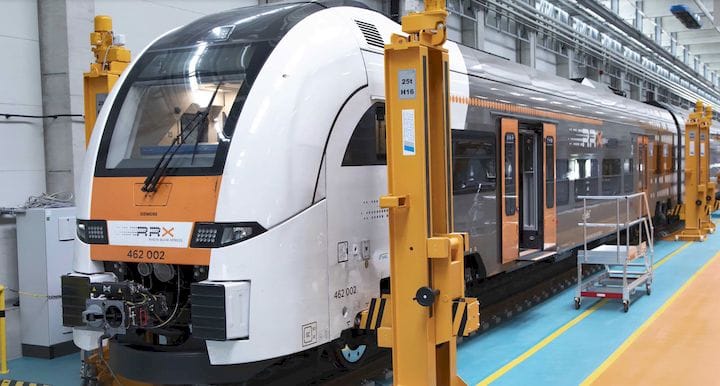![A railcar being serviced at Siemens Mobility’s new RRX Rail Service Center [Source: Stratasys]](https://fabbaloo.com/wp-content/uploads/2020/05/image-asset_img_5eb0a6bd23b33.jpg)
Stratasys announced a deal with Siemens for 3D printing, but I think there is much more behind this arrangement.
The gist of the arrangement with Siemens Mobility is the installation of a Fortus 450mc in their RRX Rail Service Center in Dortmund-Eving. This is a facility in which clients can have their rail cars maintained by experts in an efficient manner. Such service centers exist for many transport industries, including air, sea and here, rail.
The key is efficiency, as more money is made if more cars are successfully maintained with less time and effort. The new RRX Rail Service Center apparently has the “highest level of digitalization in the rail industry”. To that end, Siemens Mobility installed the Fortus device to aid in assembly. They explain:
“Siemens Mobility has now eliminated the need for inventory of selected spare parts, reduced the manufacturing time of these parts by up to 95% and can now respond to all internal and customer demands seamlessly.
Renowned as Siemens Mobility’s flagship site, the RRX Rail Service Center is expecting around a hundred trains to enter the depot every month. This level of throughput puts pressure on the supply chain and requires robust manufacturing solutions that can fulfill the wide-ranging needs of customers quickly and cost-effectively. As a result, the company invested in a Stratasys Fortus 450mc Production 3D Printer to produce replacement parts and tooling on-demand.”
Tina Eufinger, Business Development Additive Manufacturing, Siemens Mobility Division, says:
“Using the Fortus 450mc we can 3D print spare parts in a matter of hours. Parts that took 6 weeks, can now be produced in 13 hours. Within a week, we can iterate and optimize the design and then 3D print a final, customized production-grade part. This has enabled us to reduce the manufacturing time of each part by up to 95%, which has significantly sped up our ability to respond to customers.”
This is all quite terrific, but there’s a lot more going on here.
You may recall Stratasys showed a very unusual “technology demonstrator” a couple of years ago, the “Infinite Build Demonstrator”. This was a prototype device that would be able to 3D print very long continuous parts.
At the time it was a bit puzzling as to exactly who would need this. But then a bit more research revealed Stratasys’ intentions. It seems they want to address the digital inventory problem, specifically in the transportation industry.
Imagine the problem facing a rail network operator: hundreds, perhaps thousands of railcars, all obtained at different time periods and having different internal designs. Normally one would have to maintain a truly gigantic stash of spare parts for these vehicles, covering all possible components for decades’ worth of acquisitions. That’s unbelievably expensive.
While small parts can be duplicated with some effort, the real problem is in the internal panels, which were typically made with custom made molds that perhaps no longer exist. To replace them would be very costly.
That is what I think the Infinite Build Demonstrator was really all about: giving service centers the ability to near-instantly duplicate arbitrary large components on vehicles. That includes not only rail cars, but also buses, aircraft and other similar vehicles. It must surely be a very common problem.
Now we see that Siemens has set up a “digital service center”, and that Stratasys has a foothold there. The act of putting an infinite build production machine into such a facility no longer seems like a stretch: it’s simply adding another machine at this point.
Stratasys’ transformation to major manufacturing supplier takes another step forward. Investors, take note!
Via Stratasys











The debate over use of proprietary or open materials ecosystems is becoming a big topic in 3D printing.